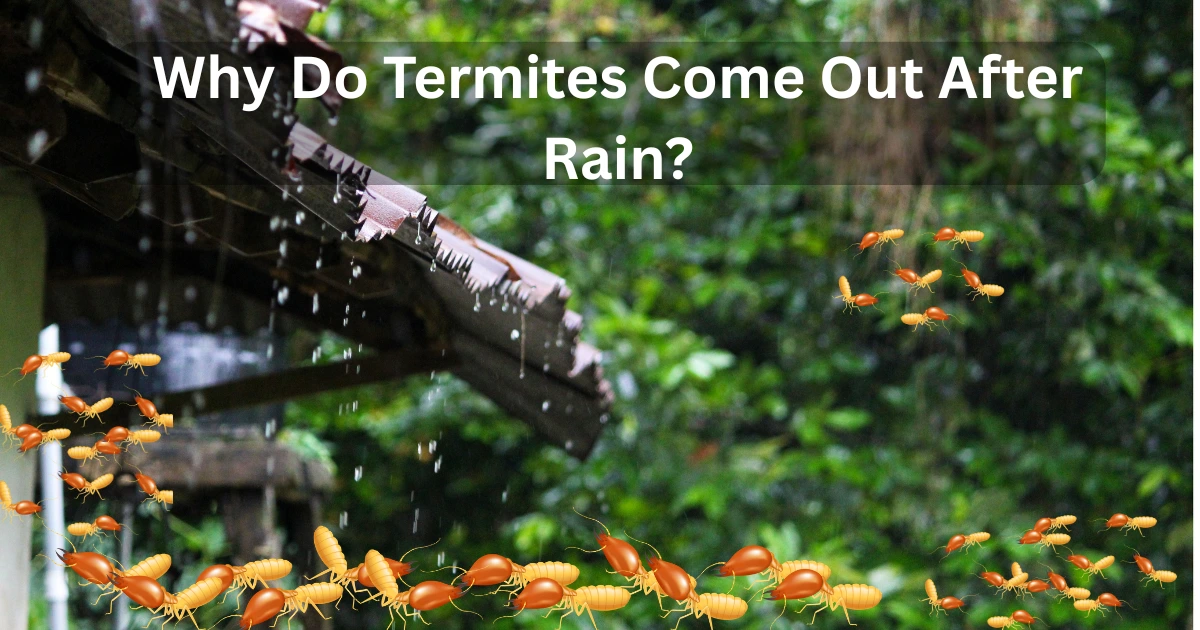Have you ever noticed tiny winged insects suddenly flying around your home just after a heavy rain? If yes, you’re not alone. These are most likely termites, and their post-rain appearance often raises concern among homeowners. But why do termites come out after rain? Is it a warning sign? Let’s explore the science behind this behavior — and what you can do to protect your home.
The Rainy Season: A Wake-Up Call for Termites
Termites live in moist, dark environments. When it rains, the soil around your home becomes softer and damp — perfect conditions for these pests to thrive.
But there’s more to it. The combination of increased humidity, softened soil, and stable temperatures creates an ideal moment for termite activity to spike.
1. Swarming Season Starts
Right after the rain, especially during the monsoon, termites begin to swarm. These winged termites — called alates — fly out of their colonies in search of new places to start a nest.
They don’t fly far. Often, they settle within or around the same home. That’s why you may see them around lights, windows, or near damp wooden surfaces.
Key Insight: If you see winged termites flying indoors, it’s often a sign of a nearby colony — possibly inside your home.
2. Rain Softens Soil — and Barriers
Normally, dry soil acts as a barrier between termite colonies and your home. But rain changes the game.
As the soil becomes moist:
-
It becomes easier for termites to tunnel.
-
Mud tunnels they build don’t collapse as easily.
-
They reach your home faster and more discreetly.
This is why post-rain inspections are critical, especially in areas known for termite problems.
3. Wood Becomes a Prime Target
Wood absorbs moisture quickly. And wet wood? That’s a buffet for termites.
After a rain, wooden doors, windows, furniture, and flooring may retain moisture, making them softer and easier for termites to chew through.
If your home has untreated or old wood, termites will seize the opportunity to attack.
4. Indoor Humidity Helps Them Thrive
It’s not just outdoor conditions. When it rains, indoor humidity levels rise too.
That means areas like:
-
Basements
-
Crawl spaces
-
Bathrooms
-
Kitchens
…can become breeding grounds for termites, especially subterranean species. Once they find a comfortable spot, they build mud tubes and start feeding quietly.
5. Termite Colonies Expand After Rain
During and after heavy rainfall, existing termite colonies can grow rapidly. They send out scouts to find more food sources — including the wooden structures of your home.
If you’ve noticed signs like:
-
Discarded wings
-
Mud tunnels on walls
-
Hollow-sounding wood
…it’s time to act.
How to Prevent Termites After Rain
Now that you know why termites come out after rain, let’s talk about prevention. Here’s what you can do:
 Inspect Your Home
Inspect Your Home
After each rainfall, check for mud tubes, damaged wood, or discarded wings near windows and doors.
 Fix Leaks and Drainage Issues
Fix Leaks and Drainage Issues
Termites love moisture. So make sure your plumbing and roof are leak-free, and that your home has proper water drainage.
 Avoid Storing Wood Near the House
Avoid Storing Wood Near the House
Firewood, wooden furniture, or even cardboard boxes stored near your home can attract termites. Keep them at least 20 feet away.
 Get a Professional Termite Inspection
Get a Professional Termite Inspection
Sometimes, infestations aren’t visible to the untrained eye. Schedule an inspection, especially during or after the rainy season.
 Install a Termite Reticulation System
Install a Termite Reticulation System
For long-term protection, consider installing an anti-termite reticulation system. It creates a chemical barrier that blocks termites before they even enter your home.
Final Thoughts: Don’t Ignore the Signs
Rain may bring relief from the heat, but it also triggers termite activity. If you notice termites coming out after a shower, don’t brush it off. Instead, take it as a signal to inspect, protect, and act fast.
Remember, early detection and prevention can save you thousands in future repairs.

